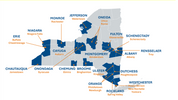Medical debt is a huge problem estimated to affect 41% of the population, 100 million Americans, at a total burden of over $2 billion. The middle class is reported to be the hardest hit.
Medical providers routinely refer their uncollected medical debt to collections agencies, who in turn use the threat of turning over uncollected debt to consumer credit reporting agencies. Medical debt is presently the largest source of debt in collections, totaling more than credit cards, utilities and auto loans combined, according to the White House.
The Urban Institute reports 740,000 New Yorkers have medical debt that has made its way onto their credit reports; people of color are twice as likely to have their medical debt reported to a credit agency; and low-income people three times more likely.
A new law in New York state amends the N.Y. Public Health Law's Fair Medical Debt Reporting Act (Article 49A) to prohibit hospitals, health care professionals and ambulances from reporting an individual’s medical debt to credit agencies, except those charged to a consumer credit card. Credit reporting agencies are ordered not to post any such medical debt information on consumer credit reports effective immediately.
By keeping medical debt off consumer credit reports, New York aims to make it easier for residents, “to get jobs, secure credit, rent an apartment, pay for their children’s education and build long-term wealth.”
In an even bolder move, Connecticut has now become the first state to decide to cancel hundreds of millions of dollars in consumer medical debt, with New York City expressing its intent to do the same, joining Los Angeles, Chicago, New Orleans and St. Paul.
More than simply removing the debt from credit reports, these jurisdictions want to relieve the hardest hit medical consumers of the debt nearly entirely.
“This is not something they did because they’re spending too much money," said Connecticut Gov. Ned Lamont, “This is something where they got hit with a medical emergency. They should not have to suffer twice.”
These medical debt removal plans involve partnering with non-profit organizations that buy up medical debt at pennies on the dollar and settle them en masse using resources gathered from charitable donations, governmental relief funds, and other monies awarded or set aside for assisting those in need due to health crises and medical care for themselves or their family members. The debt is purchased, and very low settlements (1%) are made with medical service providers and facilities. The providers usually accept the settlements because individually the debts were worthless and ready to be written off, or already sold to third parties. This allows them or the third party at least some minimal recovery.
Connecticut and New York City both plan to partner with the nonprofit called RIP Medical Debt. To qualify, a resident's medical debt must equal 5% or more of their annual income or the household income is up to 400% of the federal poverty line, about $125,000 in 2024.
RIP Medical Debt says those who are eligible in these jurisdictions do not have to apply. Their financial information will apply for them, and if they qualify, they will receive a letter letting them know their debt has been relieved, and by how much. As of today, RIP Medical Debt says it has relieved over $10 billion nationwide.
In 2022, the Consumer Financial Protection Bureau ruled state laws prohibiting medical debt reporting are not preempted by federal collection laws. Credit reporting agencies had previously agreed not to report medical debts below $500, though this scarcely addressed the scope of the problem for health service consumers.
“This is not something they did because they’re spending too much money. This is something where they got hit with a medical emergency. They should not have to suffer twice,” Gov. Lamont.
 unknownx500
unknownx500










